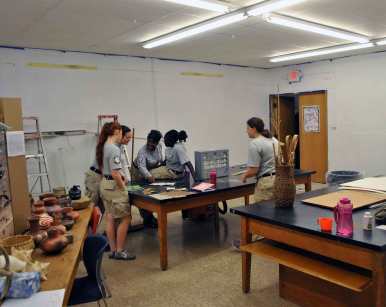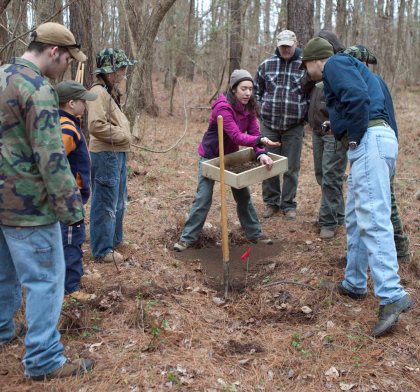 This week’s post features an interview with Jayur Mehta who is completing his doctoral studies at Tulane University in New Orleans. His dissertation work focuses on the Carson Mound group near Clarksdale, Mississippi. I first met Jayur several years ago when he was employed at the Mississippi Department of Archives and History. I have followed his blog for the past several years and found his most recent post on community outreach and service learning in his field work to be quite interesting. Jayur’s work is an excellent example of using the college classroom as an opportunity for students to employ an applied archaeology approach to community and cultural heritage development. Below is an interview with Jayur where he touches on these issues.
This week’s post features an interview with Jayur Mehta who is completing his doctoral studies at Tulane University in New Orleans. His dissertation work focuses on the Carson Mound group near Clarksdale, Mississippi. I first met Jayur several years ago when he was employed at the Mississippi Department of Archives and History. I have followed his blog for the past several years and found his most recent post on community outreach and service learning in his field work to be quite interesting. Jayur’s work is an excellent example of using the college classroom as an opportunity for students to employ an applied archaeology approach to community and cultural heritage development. Below is an interview with Jayur where he touches on these issues.
Please tell us a bit about your background and how you became interested in community outreach?
My entire archaeological career was born out of community outreach. When I was 16 years old, I was fortunate enough to participate in an East Carolina University sponsored summer camp, and during that camp, we spent 2 weeks digging at Fort Neoheroka, a Tuscarora village and stronghold built in the early 18th century. This experience fundamentally played a role in my life and career, and I would not be an archaeologist today if it were not for the East Carolina University archaeology summer program. I did not get the opportunity to engage in any community outreach until I was in my mid-20s and working for Mississippi Department of Archives and History (MDAH). It started with short public lectures at small, rural libraries, and my outreach efforts culminated at MDAH in a day-long archaeology fair/expo I helped to organize.
How do you integrate community outreach in your archeological or cultural heritage projects?
I work with community partners who are local to where I do my research. In trying to figure out how best to “do” community outreach, I realized I needed to know people in the community and what their needs actually were. I was introduced to some of the leaders of the Griot Youth Program, a non-profit dedicated to arts education, and we quickly developed a rapport that allowed us to collaborative decide how best to bring their high-school aged students together with my college students to not only learn archaeology, but also to make garden boxes and assist with the Griot summer programming.
What is the reaction to your University students who participate in public outreach projects as part of their field season.
Most of my students have really enjoyed doing service projects, whether for archaeology or environmental studies. In our post-service reflection sessions, I have noticed that students like talking and collaborating with other students who are older or younger, and they enjoy sharing information they have learned. Occasionally I’ll get the recalcitrant student but, in general, they are eager to participate in activities that are outside of the classroom and relevant to the content of the course. I think this is the most important element of outreach and service learning – any and all activities should be related to the mission statement of the course.
How has your public outreach evolved over the past few years?
My public outreach was initially formulated while working for a state agency, not as a college professor, so my early outreach efforts entailed speaking with an incredibly broad public audience. Whether in lectures, artifact “show and tells”, or in archaeology fairs, archaeology was the focus. Now however, I teach archaeology and environmental studies to students, and my outreach efforts are focused on bringing students into contact with communities and community partners. It has been an exciting shift in focus – I like working with a specific and captive population and tailoring my pedagogy to their needs, which I can predictably anticipate because of our daily classroom interactions.
What do you consider your most successful recent efforts in public outreach or community engagement?
I can think one very successful and recent outreach event. Last summer, one of my students from the field school became particularly enamored of the Griot Youth Program and wanted to do something good for them. Given they are an arts focused non-profit, he wanted to help them with their programming infrastructure. When he approached me after the class and said he wanted to do something for them, I helped with identifying grants he could write for the Griot Youth Program. Unfortunately, these proved to be too time consuming. This turned out to be a blessing in disguise – instead, my student and I organized a fund-raising concert that provided enough funds for the Griot Youth Program to buy a new PA system. While this service work was not directly related to the course, my student met these partners through the course and he identified his own path to helping my community partners. I think he did a lot of good here, and I’m very proud of his efforts!
What are some of the biggest lessons you have learned from your educational and outreach program?
In general, I think it is that small groups work the best, regardless of the kinds of activities taking place. I like giving one on one attention to folks or at the least, engaging with them in small groups. Lecture is a great way to target a large group of individuals but lectures are only so stimulating. This brings me to my other point, which is that outreach, education, and service do not happen in a vacuum. You need people at your side helping with outreach and service and you need partners to participate and help guide your outreach work. Ideally, outreach and service are reciprocal between community and educator – for this collaboration to be effective, good working friendships are important.
What do you consider to be the biggest obstacle in developing effective educational outreach?
At the end of the day, outreach and service learning should not just be an “extension” of the fields in which we operate. Instead, service should be a fundamental component by which lessons are taught. This is very difficult to implement and requires a fair bit of planning and hard work. Sometimes, and I feel this often, it is easier to lecture or to teach concepts outside of a community-oriented context. The challenge is to make yourself, and your students, care about the well-being of communities in which they living.
The idea of working on development projects with the host community that are not related to immediate research interests seems somewhat of a recent development for archaeologists. What got you interested in adding this component?
While the arts programming that is the focus of the Griot Youth Program is not necessarily related to archaeology, I think it is related to the overall mission of academia and of the liberal arts, which is to provide individuals with the necessary tools to build a future, to help others, and to have a complex and historical understanding of human society. By working with underprivileged youth in the Mississippi Delta, my students learn about another sector of society and become familiar with the needs and wants of humans they may never otherwise encounter. These meetings and relationships are important if scholars and academics are going to effectively work towards building a more verdant and equitable future for all of society. I do service and outreach in my classes because I want students and communities-in-need to get together and to collaboratively find solutions to problems, whatever they may be. In the end, I want my students to know that the world and its problems are in their hands and that they have to find ways to address them. I want them to be citizens and active agents of equity. I believe through service and outreach, I am helping to put them on this path.
Do you have any words of wisdom for archaeological and museum professionals to enhance their outreach work?
Talk! Always engage with strangers about your work and make friends in your community. I decided that service learning and outreach would be important in Clarksdale because I was tired of going there every summer and making random friends in bars, only to forget them by next summer. If archaeological heritage is to be preserved and cared for, it is up to us not only to do the research, but also to help others understand why a mound, creek bed, or field are important cultural resources that should be preserved.
Jayur Mehta can be contacted at jmehta(at)tulane.edu
















